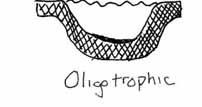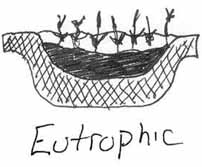Lake Study On July 6, 1992, Snell Environmental, Inc. (SEG) presented an overview and results of their study on Portage Lake in a public hearing forum. The goal of the study was to identify procedures and methods required in order to control sources of nutrient loading into Portage Lake. These sources were studied and measured through field observations, professional literature, background and history of the lake, appropriate mathematical models and selective sampling. This project has since been passes on to the natural and applied science classes that are run by Mr. Hunter. He in turn takes a group of students out on the Sandpiper II, which is owned and operated by Kevin Hughes our elementary principle, each spring and fall. While on the boat the students take many measurements that are used to determine the health of the lake, and to determine whether the overall quality is increasing, decreasing, or remaining about the same. Eutrophication refers to the accumulation of nutrients, which produce increasing amounts of aquatic plants. As the resulting aquatic plant growth dies each year, sediments fill in the bottom of the lake. This is a natural process that takes thousands of years to fill in a large, deep lake, and less time in a shallow lake. Most of the tests done out on the lake are actually done by the students in Mr. Hunters science class, there are only two which have to sent into the lab to be analyzed: chlorophyll-a and phosphorus. 1 2 3 This article was written by Alex Gruss and originally printed in the May 4, 2001, Portager Print |
There are six different tests that are run by the students and supervised by Mr. Hunter. Tests include those for dissolved oxygen, pH tests, chlorophyll-a, phosphorus, temperature, and clarity. Dissolved oxygen levels are monitored because D.O. is needed for aquatic animal life. The decomposition of plants and animals uses dissolved oxygen and radically decreased levels of D.O. would indicate that the volume of decomposing matter is too high. pH tests are done to monitor the overall acidity or alkalinity level of the lake. A healthy lake level is around 8 on the pH scale. Portage Lake is founded on for the most part sedimentary rock with high limestone content and tends to by slightly alkaline in nature. Chlorophyll-a is a component of plant cells and is used to measure the concentration of small aquatic plants like algae. This test can help predict the possible outbreak of an algae bloom. The phosphorus test is most important aquatic plant nutrient and is essential for plant growth. Plants readily use phosphorus and if it is not used then is settles the bottom of the lake where it stays until it is used. Temperature is an important factor because many of the physical, biological, and chemical characteristics of a lake are directly affected by temperature. The last test done is a secchi disk reading. The secchi disk determines the clarity of the water, over the past few years the clarity has increased tremendously because of a large number of Zebra Mussels and other filter feeders. These tests are done at three different sites on the lake: the East Basin, West Basin and a shallow site located near Onekama Marina. The data acquired from these tests is very important and should not be taken lightly. The tests can tell us whether or not increased boat traffic is harming our lake or not bothering it at all. We find out when the annual turnover is. A turnover is basically when the water at the top of the lake replaces that at the bottom of the lake essentially turning it over. The tests can also tell us whether or not farming in the remote area is affecting the phosphorus and pH levels of the lake, this would be indicated by a dramatic increase or decrease in either one. The township board will be using the data presented by Mr. Hunters applied science class to make a decision on whether or not certain restrictions should be place in the surrounding lake area. This could turn out to be a critical decision and the data from the lake study is a very large part of it. |


